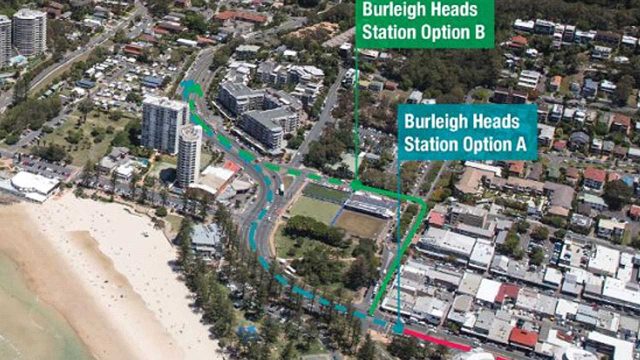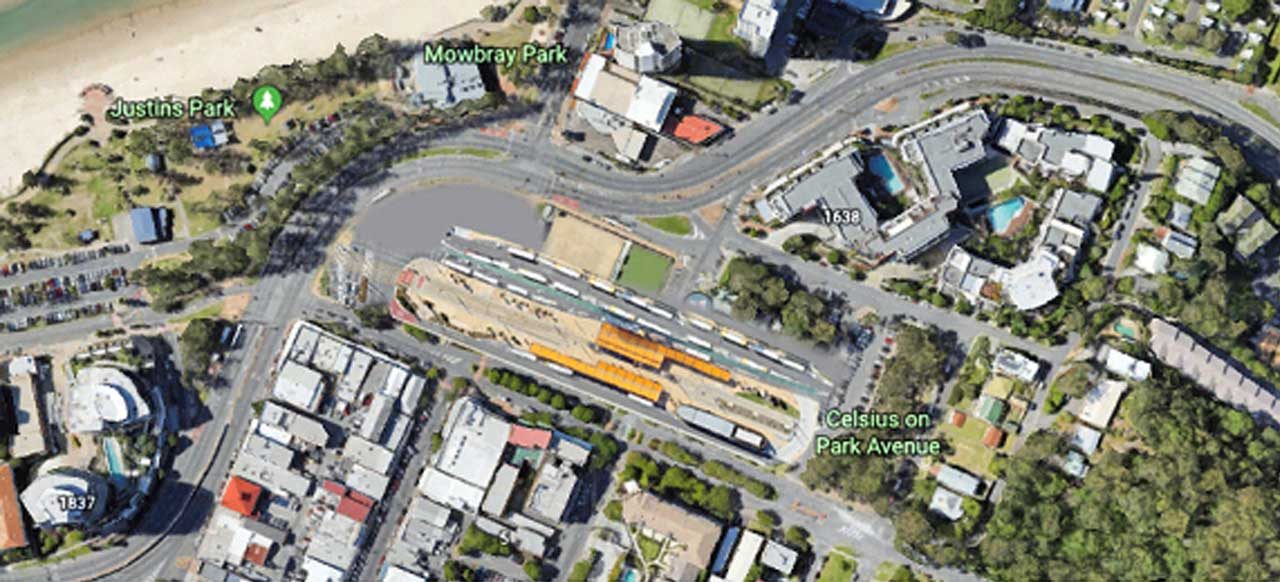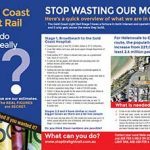Gold Coast Light Rail, Burleigh to Broadbeach
CLICK HERE to download, read or print our "Stop The Light Rail" brochure.
Broadbeach to Burleigh, some quick highlights
The promoters of the Light Rail have a plan out, it shows the tram and bus stop in Park Ave at Burleigh

Is it really only going to be that small?
Oops, we forgot about this and forgot about that, and we’ll need to do this and do that and…………………..
Here is an image of the Broadbeach interchange overlayed on Connor St at Burleigh.

That’s quite a different picture?
There are 20 buses parked here and room for 4 tram carriages? Where will they all park if we need a tram every 1 ¼ minutes? Where would all the buses park (at 3 buses for every ½ full tram, adds up to 144 buses per hour)?
Confused? Read on…………..
The trees go, and the War Memorial is in danger. We wonder what the truth is?
Does it seem funny that they have such a large interchange at Broadbeach and not one at Burleigh?
Broadbeach to Burleigh population reality:
For us taxpayers to pay the $102 million interest per year:
- At $5 per trip, we need 55,890 passengers on the tram each day. That’s more than the total population of 55,000 along Stage 3 stretch (based on Australian Bureau of statistics 2016 statistics, see the calculations on page 4)
- On Stage 1, about 26% of the population numbers catch the tram (is patronage higher on stage 1 than the rest as it was the premier bus route on the Gold Coast and it also services the Hospital and the University, and the tram doesn't carry any more passengers than the buses did)
- If we use the 26% of the population and work backwards, we can work out the population needed along the Stage 3 track. So that means we take 65,000 times 100, divided by 26, producing 214,000 people
- That means to break even on the Broadbeach to Burleigh run the population has to increase by 159,000
- 159,000 is almost the full Gold Coast population increase forecast in the next 10 years- from Yatala to Tweed
Tram numbers on the Broadbeach Burleigh run
There is some commentary on tram costs on page 4 of this website.
To pay its way, the tram service, at a construction cost of $1 billion, and the operating and interest payments per year are $102 million, needs to carry 55,890 people per day on the Burleigh/Broadbeach section.
55,890 people are calculated from the interest and operating costs of $102 million per year divided by $5 per ticket and 365 days.
$102 million per year equates to $14.5 million per kilometre per year in interest and operating costs.
- If we had to service the 55,890 passengers, we’d need 930 buses running each day (60 people per bus).
- But for a tram, which carries 309 people we’d only need 180 trams per day.
- If the trams run for 18 hours a day, and everyone is full, we’d need 10 trams per hour or one every 5 minutes,
- But if they are half full, we’d need a tram every 3 minutes.
- Or if they are ¼ full, we’d need a tram every 1.5 minutes or 40 per hour.
Where would they park?
- Let’s assume the trams are only half full,
- Each tram needs buses to supply the people, so we need 3 buses servicing each half full tram.
- A tram every 3 minutes is 20 trams per hour, and that makes 51 buses per hour servicing the tram?
The numbers are farcical!
Broadbeach to Burleigh costs
A quick overview of the cost forecasts here, and the impacts:
The costs will be about 1 billion dollars for 7 kilometres (forecast at $600 million, but the previous forecast left out the roadworks, so add another $400 million), and that provides:
- $150 million per kilometre (but we don’t think we’ve got all the costs as Sydney and Newcastle are budgeting $220 million per kilometre),
- Interest cost $81 million every year,
- Operating costs (loss) based on stage one is $6.5 million per kilometre, but reduced to $3 million/km/year for Stages 2,3,4, so $21 million,
- Total interest and operating cost (loss) per year $102 million,
- Or loss of $14.5 million/km/year.
We build something for $1 billion, and it loses $102 million every year. Does that make sense?
What else could we buy for the $1 billion?
For the $1 billion, we could:
- Support 1.1 million underprivileged children across Australia with $900 each.
- Build 20kms of 8 lane freeway (Robina to Tweed),
- Employ 6,600 police,
- Support 20,000 aged people at $50,000 each.
- Pay for 200,000 emergency care beds at $5000 each,
- Or build 66 new schools at $15 million each
For the 102 million per year, every year we could:
- Build 2 kms of 8 lane freeway,
- Employ 680 police,
- Support 2,040 aged people,
- Provide 20,400 emergency care beds,
- Build 6 new schools
More calculations for the 7kms from Burleigh to Broadbeach:
While your reading, look at it from this one viewpoint: how much could Burleigh or Miami State School’s benefit from $16.8 million spent on interest every year per kilometre outside the school’s share of the road?
If we are going to borrow another 1 Billion dollars are there not more essential community services we could be funding?
- Population along the route from Burleigh to Broadbeach 55,000
- Real forecast construction cost based on Stage 1 and 2 $1 billion
- Cost per resident along the route to build $18,181
- Cost per family of three to build $54,543
- 7km long so cost per kilometre $150 million/km
- Total annual operating and interest costs $102 million,
- Interest per year $81 million
- Part at 9.22% and part at 5%
- Calculated operating costs per year $21 million ($3 million per kilometre)
- Annual cost per persons per year $1,854
- Annual cost per kilometre $14.5 million
- Patronage % of Stage 1 that use the light rail 26%
- Ticket price required if 26% (14,300) of population use Stage 3 $20
- Ticket price if 13% (7,150) of population use Stage 3 $40
- Passengers required per day at $5 per ticket 55,890
(Remember our current population is only 55,000, so $102 million per year/$5/365 days equals 55,890)
- Population required for 26% patronage 214,000
- (Population increase required 159,000)
- Population required at 13% patronage 428,000
- (Population increase required 373,000)
Do you think we've been sold a lemon?
And they are trying to sell us more?
